Dynamic properties and liquefaction behaviour of cohesive soil in northeast India under staged cyclic loading
Shiv Shankar Kumar,A.Murali Krishna,Arindam Dey
Department of Civil Engineering,Indian Institute of Technology Guwahati,Assam,781039,India
Keywords:Cohesive soil Dynamic soil properties Liquefaction potential Cyclic triaxial tests Staged cyclic loading
A B S T R A C T Estimation of strain-dependent dynamic soil properties,e.g.the shear modulus and damping ratio,along with the liquefaction potential parameters,is extremely important for the assessment and analysis of almost all geotechnical problems involving dynamic loading.This paper presents the dynamic properties and liquefaction behaviour of cohesive soil subjected to staged cyclic loading,which may be caused by main shocks of earthquakes preceded or followed by minor foreshocks or aftershocks,respectively.Cyclic triaxial tests were conducted on the specimens prepared at different dry densities(1.5 g/cm3and 1.75 g/cm3)and different water contents ranging from 8%to 25%.The results indicated that the shear modulus reduction(G/Gmax)and damping ratio of the specimen remain unaffected due to the changes in the initial dry density and water content.Damping ratio is significantly affected by confining pressure,whereas G/Gmaxis affected marginally.It was seen that the liquefaction criterion of cohesive soils based on single-amplitude shear strain(3.75%or the strain at which excess pore water pressure ratio becomes equal to 1,whichever is lower)depends on the initial state of soils and applied stresses.The dynamic model of the regional soil,obtained as an outcome of the cyclic triaxial tests,can be successfully used for ground response analysis of the region.
1.Introduction
Several studies and earthquake evidences indicated the occurrence of liquefaction in loose saturated sand deposits at shallower depths.Subjected to cyclic loading,the increase in pore water pressure(PWP)causes the reduction in shear strength due to the release of contacts between the particles.Apart from sandy soils,which are more commonly prone to liquefaction,natural soil deposits in the field comprises different types of soil and soil mixtures such as silty-sand,silt,silty-clay,clay or any combinatorial soils.Among these soils,cohesive soil,owing to its small particle size and substantially low void ratio,is considered to be more resistant to liquefaction in comparison to the cohesion less soils in the event of an earthquake.However,severe damages of structures,such as large deformation of ground and collapse of fills,were observed due to failure of clay base layers during earthquakes(Hyodo et al.,1993).Therefore,before designing the aseismic structures on clay or silty-clay soil,geotechnical engineers should know the liquefaction susceptibility and the dynamic properties of such soils as well.Several studies reported the parameters influencing the dynamic properties of cohesive soil(Hardin and Drnevich,1972a;Kokusho et al.,1982;Ishibashi and Zhang,1993;Dutta and Saride,2015;Sas et al.,2015;Gu et al.,2016),i.e.the effective confining pressure,shear strain,plasticity index,frequency of loading,number of loading cycles,void ratio,degree of saturation,over consolidation ratio and particle size.
Researchers have also conducted cyclic tests(e.g.resonant column tests,cyclic triaxial tests and cyclic simple shear tests)to anticipate the liquefaction behaviour of silt,sand,clay,silty-clay and silty-sand soils(Kokusho et al.,1982;Vucetic and Dobry,1991;Matsui et al.,1992;Ansal et al.,2001;Okur and Ansal,2007;Dutta et al.,2017;Lei et al.,2017;Price et al.,2017;Thian and Lee,2017;Xiao et al.,2018).It was concluded that the behaviour of soils,i.e.the degradation in stiffness or cyclic strength,is strongly influenced by the rise of PWP,governed by the soil plasticity and loading frequency.The increase in PWP in saturated cohesive soil is relatively less than that in the cohesionless soil,because of the cohesion between the soil particles offering higher resistance to particle separation during seismic shaking.Therefore,the cumulative pore pressure may not be the only suitable reason to define the cyclic failure criterion for clay or cohesive soils(Li et al.,2011).Brayand Sancio(2006)reported that the plasticity index(PI)is a better indicator of the liquefaction susceptibility of cohesive soil,while Boulanger and Idriss(2006)described the failure criterion in terms of cyclic softening.Since pure clayey soils are not susceptible to liquefaction,the amount of clay present in the soil is one of the good indicators towards liquefaction susceptibility of such soil(Sancio et al.,2003;Tan et al.,2013).The variations in clay content can be best represented by PI.Several other liquefaction criteria were also proposed by the researchers,one of which is the Chinese criterion(Wang,1979).According to this criterion,soil is susceptible to liquefaction if clay soil contains 15%-20%particles(by weight)smaller than 0.005 mm,LL=21%-35%,PI=4%-14%and wc/LL>0.9.In a similar fashion,Andrews and Martin(2000)modified the upper limit of LL to be 32%and size of fine contents to be smaller than 0.002 mm(i.e.less than 10%by weight)while redefining the same criterion.Studies on the cohesive soil reported a failure criterion based on the number of loading cycles at which an arbitrarily predetermined double amplitude(DA)failure-axialstrain(e.g.2.5%,3%,5%,10%,15%or 20%)is reached(Prakash and Sandoval,1992;Yasuhara et al.,1992;Hyodo et al.,1994;Perlea,2000;Li et al.,2011).Thus it is aptly clear that the possibility of liquefaction depends on the initial state of cohesive soils.Very recently seismic requalification studies of important structures located in high seismic zone have been initiated(Dammala et al.,2017a),where understanding of underlying soil behaviour is critical.
Cyclic triaxial test apparatus is the most common type of apparatus used for such experiments to understand the dynamic characteristics of cohesionless and cohesive soils.Hence,in this respect,the methodologies adopted in the present research do conform to the earlier researches.The highlight and importance of the present research lie in the application of cyclic triaxial test to identifying the dynamic properties and liquefaction behaviour of the regional red cohesive soil found in abundance in and around Guwahati region.Only limited literature is available about the dynamic characterisation of the soils in the said region(Guwahati and northeast region of India);moreover,all the literature deals with the dynamic response of cohesionless soils.This article provides the documentation of the dynamic response of the cohesive soil available in the region.The characterisation of the regional cohesive soil holds importance in its application to ground response analysis(GRA).In the absence of the dynamic response of the regional soils,it is a common practise to use the standard dynamic models(Vucetic and Dobry,1991;Darendeli,2001;Roblee and Chiou,2004)for GRA studies.Similar approach has been practised for cohesionless soils(Seed and Idriss,1970;Darendeli,2001).However,Kumaret al.(2017)showed that the regional cohesion less soils can exhibit substantially different dynamic behaviours as compared to the standard models for similar soils.The same understanding holds good for cohesive soils as well.For conducting the tests,soil specimens were prepared at maximum dry density(MDD)of 1.75 g/cm3,optimum moisture content(OMC)of 19.3%and field density of 1.5 g/cm3with varying water contents(8%,15%and 25%).Sincewatercontent in the field varies significantly during seasonal variation,varying percentage of water contents was chosen to interpret the soil behaviour in the field during such seasonal conditions.The prepared specimens were subjected to different amplitudes of stresses(based on cyclic stress ratio(CSR))having a loading frequency of 1 Hz.
2.Study region
The entire northeastern region of India is located at the most seismically active region in the world(IS 1893-1,2002).Based on the pastearthquake data,tectonic setup andgeology,Guwahati City is found to be surrounded by six tectonic blocks,i.e.Shillong Plateau,Eastern Himalayas,Brahmaputra Valley,Surma Valley,Naga Hill and Arakan Yoma(Raghukanth et al.,2008).This region has experienced several devastating earthquakes of different moment magnitudes ranging from M5 to M8.7(Nath et al.,2008).Raghukanth(2008)reported that during 1950 Assam earthquake,the region of Assam experienced extensive liquefaction,over an approximate area of 126 acres(1 acre=4046.9 m2).In this regard,owing to the scanty literature,it is imperative to investigate and evaluate the dynamic properties of northeastern soil.It is a common practise,on behalf of the geotechnical engineers,to perform GRA using the existing dynamic models for sand(proposed by Seed and Idriss,1970),clay(proposed by Vucetic and Dobry,1991),and combinatorial soil(proposed by Ishibashi and Zhang,1993).In the absence of proper region-specific dynamic model,the use of the standard soil models might lead to the inaccurate estimation of the ground response parameters involved in aseismic design(Kumar et al.,2018).Estimation of dynamic properties of sandy soils is well reported for deposits in northeast India(Kumar et al.,2017).The study presents the dynamic properties and liquefaction evaluation of the typically available cohesive soil nearby Guwahati City(Assam region),which can be useful for the proper assessment of GRA in this region.
3.Test material and liquefaction susceptibility criterion
3.1.Description of test material
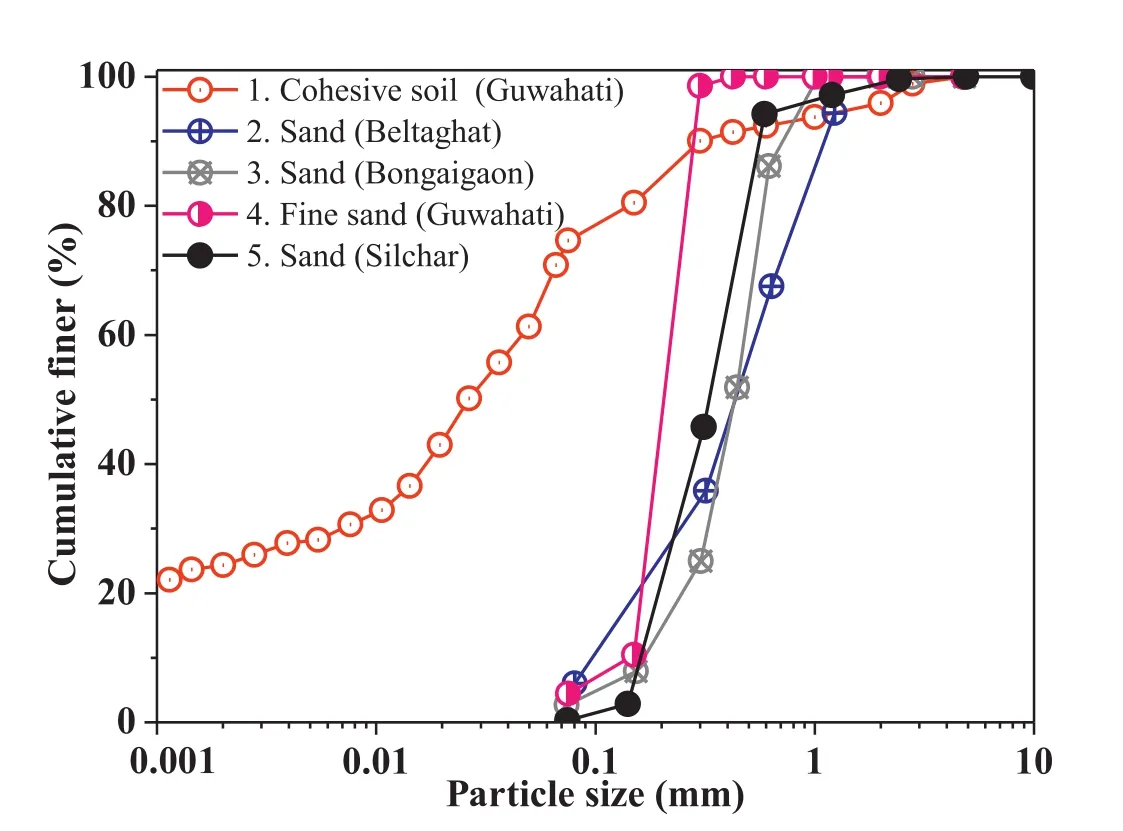
Fig.1.Particle size distribution of prevalent soils of northeastern region of India(1-Present study;2-Govinda Raju(2005);3-Dammala et al.(2017b);4-Kumar et al.(2017);5-Paul and Dey(2007)).
Cohesive soil available near Guwahati region was used for this study.The specific gravity(Gs)of the soil was found to be 2.65(ASTM D854-14,2014).As presented in Fig.1,the particle size distribution of the soil obtained from wet sieve(ASTM D6913/D6913M-17,2017)and hydrometer analysis(ASTM D7928-17,2017)exhibited a composition of 21.23%clay(<0.002 mm),48.5%silt(0.002-0.075 mm),and 30.27% fine sand(0.075-4.75 mm).The values of liquid limit(LL),plastic limit(PL)and PI were determined as 41.5%,22.6%and 18.9%,respectively(ASTM D4318-17e1,2017).The MDD and OMC of the soil were found to be 1.75 g/cm3and 19.3%,respectively(ASTM D698-12e2,2012).As per unified soil classification system(USCS)(ASTM D2487-11,2011),the soil is classified as low plastic cohesive soil.As per the soil map,the northeastern region of India primarily consists of six predominant types of soils,i.e.mountain soils,red loamy soils,terai soils,alluvial soils,mixed red and black soils,and laterite soils.Out of these soil types,the red loamy soil and the alluvial soil are extensively found in the states of Assam and Nagaland.The alluvial soils are predominant in the river basins of the northeastern region,and are mostly coarse or fine sandy soils,with moderate fines content(silt and clay).The next predominant soil is the red soil(lateritic or loamy),formed as a result of weathering of metamorphic rocks,or due to alternating cycles of wetting and drying caused by seasonal rainfalls,respectively.These soils are predominantly fine soils,with high percentage of clays along with appreciable percentage of silts.These types of red cohesive soils are prevalent in and around Guwahati region.Along with the particle size distribution of the cohesive soil used in the present study,Fig.1 shows a comparison of the particle size distributions of other soils available in the northeastern region of India(Govinda Raju,2005;Paul and Dey,2007;Dammala et al.,2017b;Kumar et al.,2017).The physical properties of various soils are provided in Table 1.Apart from a few studies illustrating the dynamic characteristics of only the sandy or silty-sand soils available in the northeastern region of India,there is no study conducted to assess the dynamic characteristics of red cohesive soil,the second most prevalent soil in the region.Fine content is an important aspect which is influential in the liquefaction behaviour of cohesive soils(Bahadori et al.,2008;Sadrekarimi, 2013).In the present study,the fine content of the red cohesive soil was obtained approximately to be 50%-60%.It is worth mentioning that the present study emphasises on investigating dynamic response of the specimen,along with the estimation of dynamic and liquefaction properties.However,the influence of fine content and its variation on the liquefaction behaviour of the stated specimen is beyond the scope of the present article.
3.2.Liquefaction susceptibility criterion
Fig.2 presents the Atterberg limits chart,proposed by Boulanger and Idriss(2006),to define the liquefaction susceptible criterion for soils.It shows that any particular soil can exhibit clay-like,sandlike,or intermediate behaviour,depending on the representative PI and LL values of the specimens.In the present study,the collected soil possesses LL=41.5%,and nearly 21.23%particles(by weight)are smaller than 0.002 mm,which places the specimen just beyond the boundary of liquefaction susceptible soils(as per the Chinese criterion and the modified criterion by Andrews and Martin(2000)).Seed et al.(2003)reported that the soils with PI<12%,LL<37%and wc/LL>0.8 are considered as potentially liquefiable,represented by Zone A in Fig.2,whereas soils having PI=12%-20%,LL=37%-47%and wc/LL>0.85 are classified as soils moderately susceptible to liquefaction(represented by Zone B in Fig.2).The soils lying beyond Zone B(defined as Zone C)are not susceptible to liquefaction.Bray and Sancio(2006)also reported that the soils with PI>18%are not susceptible to liquefaction,whereas Boulanger and Idriss(2006)reported that the fine-grained soils that exhibit clay-like behaviour and have PI≥7%are susceptible to liquefaction.It can be observed that the soil considered in the present study,having PI=18.9%(marked by star in Fig.2),is located near the boundary of Zones B and C.Hence,this soil might exhibit an intermediate or a clay-like behaviour,and may or may not be susceptible to liquefaction.
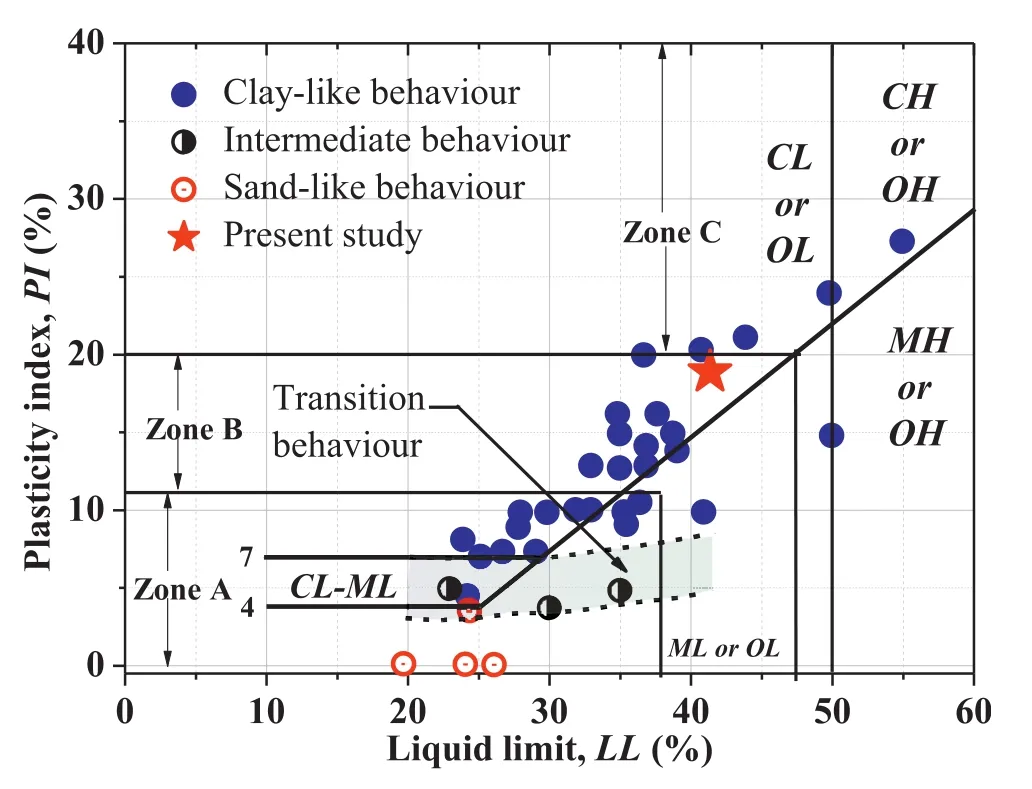
Fig.2.Atterberg limits chart showing representative values of soils which exhibit claylike,sand-like,or intermediate behaviour(after Boulanger and Idriss,2006)(CL or OL-Low plastic clay or low plastic organic clay,CH or OH-High plastic clay or high plastic organic clay,MH or OH-High plastic silt or high plastic organic silt,ML or OLLow plastic silt or low plastic organic silt).
4.Test apparatus and experimental program
Cyclic triaxial apparatus was used for the experimental investigations.The apparatus consists of a loading frame of 100 kN,fitted with a pneumatic dynamic actuator having a displacement range and operational frequency range of 0-30 mm and 0.01-10 Hz,respectively.The details of instrumentations available with the apparatus are described in Kumar et al.(2017).All the tests were conducted on the remoulded cylindrical soil specimens of 70 mm in diameter and 140 mm in height(ASTM D3999/D3999M-11e1,2011).Fig.3a shows the mould to prepare the cohesive soil specimens.To prepare the soil specimen,dry soil of a specified weight was firstly mixed with the required amount of water.Once the water was uniformly mixed with the soil,the entire quantity of water-mixed soil was transferred into the mould from one end,while the other end was maintained fixed with the collar(Fig.3b).Thereafter,compaction was done from both ends by giving simultaneous equal rotation to the collars,maintaining uniformity of the specimen,till the specimen length of 140 mm was obtained.Fig.3c presents the specimen prepared in the mould,which was taken out by the help of extruder.
The soil specimen,wrapped within the rubber membrane,was then kept on the base pedestal of triaxial apparatus.A vacuumpressure of 15-20 kPa was applied before removing the mould to establish proper contact between rubber membrane and circumferential boundary of the soil specimen.Subsequently,the triaxial cell was mounted on the base plate and then filled with de-aired water,followed by simultaneous application of cell pressure(CP)of 15-20 kPa and release of vacuum pressure(Ishihara,1993).This application of CP was done to prevent the flow of CO2through the interface of rubber membrane and soil boundary and to achieve quick saturation.The specimen preparation was followed by subsequent saturation and consolidation stages.In order to expedite the saturation process,the specimen was flushed with CO2for 45 min to 1 h,at a pressure lower than the initial CP,i.e.15-20 kPa(as suggested by Ishihara(1993)).Subsequently,de-aired water was passed through the CO2flushed specimen.The water pressure head was maintained less than the existing CP of 15-20 kPa.To attain the saturation,the CP and back pressure(BP)were then gradually increased in stages by maintaining an almost constant differential pressure of 10 kPa.After each increment of CP,the Skempton’s pore pressure parameter(B)was estimated to check the saturation status.The specimen was considered to be completely saturated when the B-value was obtained to be greater than 0.96.The time taken in saturation for one specimen,i.e.from the application of CO2to achieving the B-value greater than 0.96,was 4-5 d.After attaining the saturation,the specimen was isotropically consolidated to a targeted effective confining stress(σ′c)of(50 ± 2)kPa,(100 ± 2)kPa or(200±2)kPa,by increasing the CP,while maintaining a constant BP.The time taken for the consolidation process depends upon the dry density and water content at which soil specimen was prepared(Fig.4).The consolidated specimens were then subjected to cyclic loading.Cyclic tests performed on the cohesive soil specimens,prepared at different dry densities and water contents,with different investigating parameters are shown in Table 2.The consolidated specimens were then subjected to stress-controlled staged cyclic loading with sinusoidal waveform of frequency(f)of 1 Hz(Table 2).

Table 1Physical properties of tested cohesive soil and other soils present in Guwahati region.
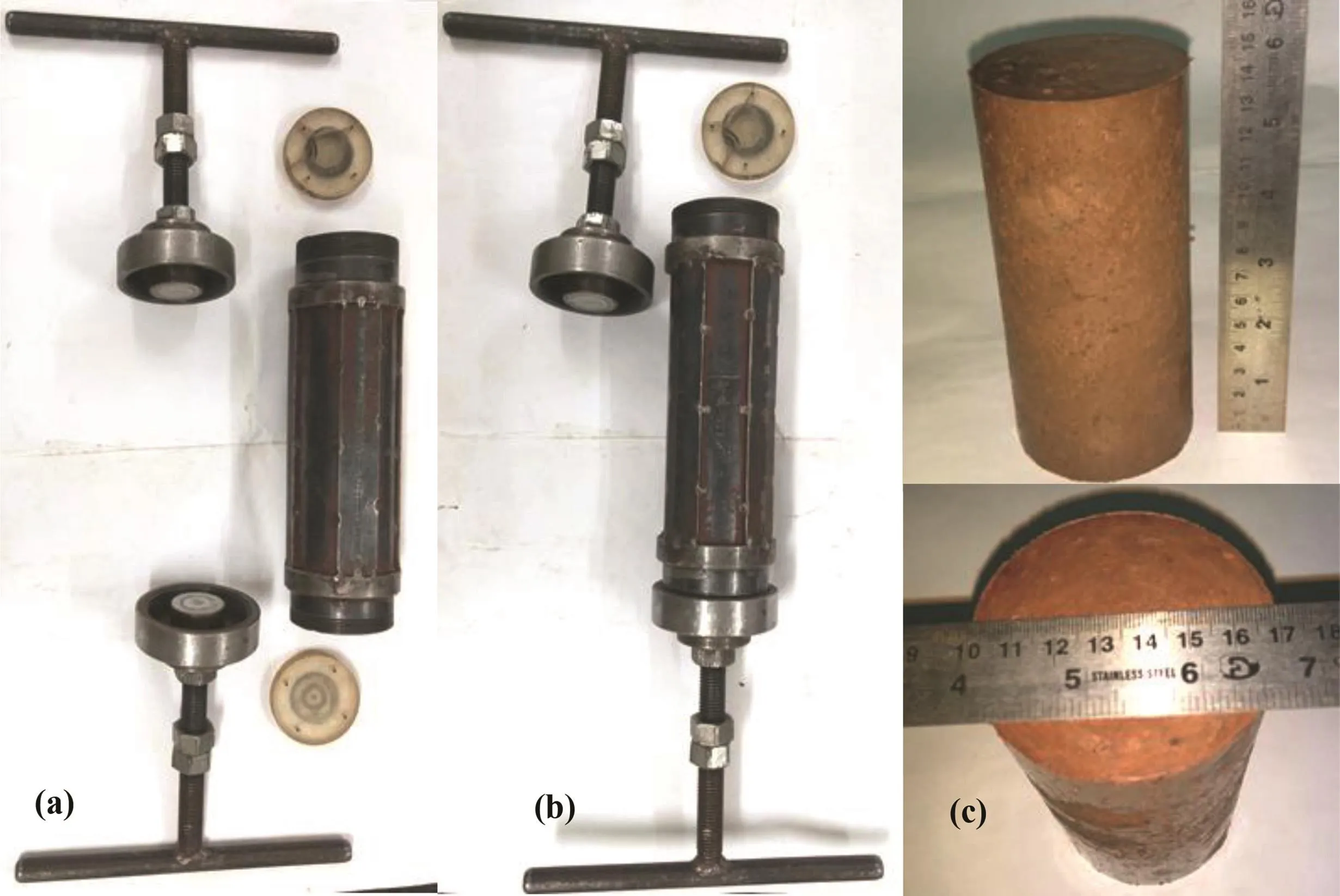
Fig.3.(a)Mould for the preparation of cohesive soil specimen;(b)Mould ready to be filled with water-mixed soil from one end,while the other end is fixed with the collar;and(c)Prepared specimen.
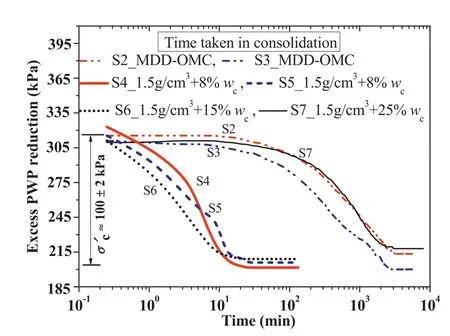
Fig.4.Excess pore water pressure(PWP)reduction with elapsed time during consolidation.
Stress-controlled cyclic triaxial tests were conducted to evaluate the shear modulus and damping ratio,as well as the liquefaction potential,of cohesive soil by applying staged cyclicloading.Since strain-controlled tests require a new test specimen each time for a different magnitude of applied shear strain amplitude,several tests with new specimen have to be conducted for the evaluation of strain-dependent dynamic properties of soils.Alternatively,stress-controlled loading is a good choice,where a single test specimen provides the dynamic properties of soil at various strain levels.In this study,staged cyclic loading was applied on the specimens in stress-controlled manner as presented in Fig.5.Yoshida(2015)has also reported the importance of staged loading in comparison to the single stage test(i.e.strain controlled test).This type of loading(staged cyclic loading)represents a more realistic approach to evaluate the dynamic response and properties of soil since the same soil is expected to experience different stress levels during a single earthquake event composed of main shock,fore shocks and aftershocks with different intensities and magnitudes.
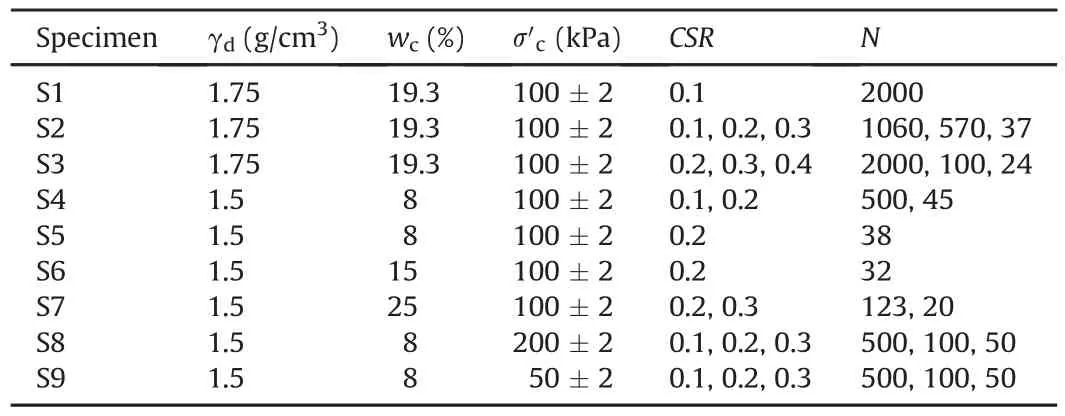
Table 2Dry density and water content for the prepared specimens,and the loading cyclic stress ratio(CSR).
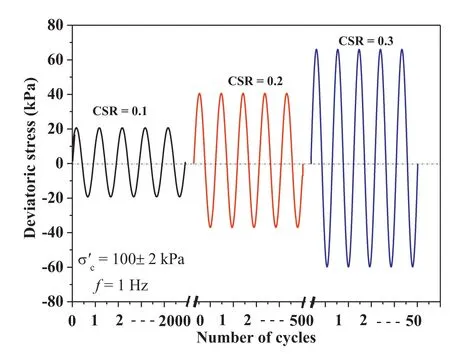
Fig.5.Typical stress-controlled staged cyclic loading used in the present study.
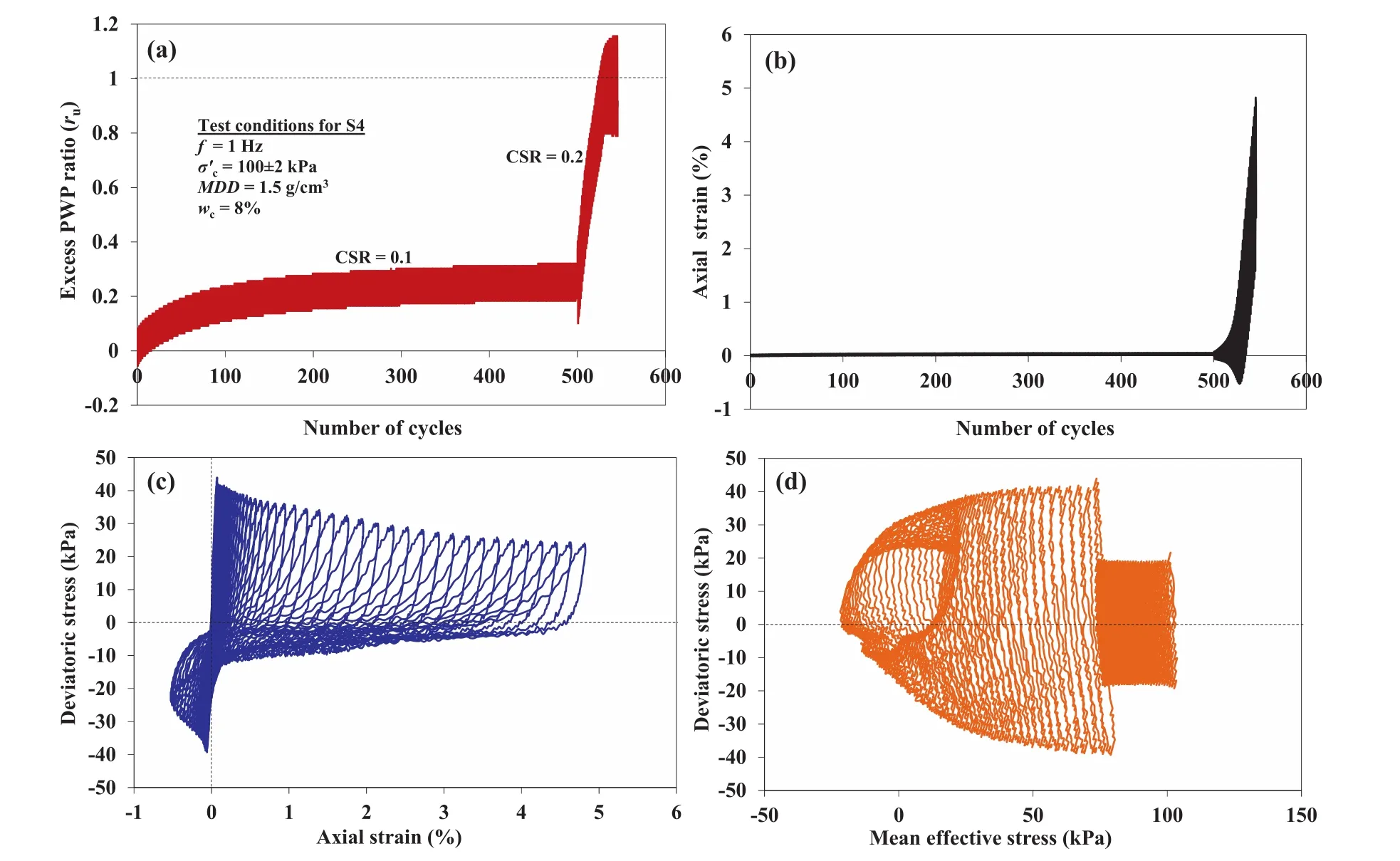
Fig.6.Typical results from stress-controlled cyclic loading of cohesive soil specimen S4 prepared at MDD=1.5 g/cm3,wc=8%and tested atσ′c=100 kPa,f=1 Hz and CSR=0.1 and 0.2:(a)Variation of excess pore pressure with loading cycles;(b)Variation of axial strain with loading cycles;(c)Variation of deviatoric stress with axial strain;and(d)Cyclic effective stress path.
5.Results and discussions
Typical results obtained from the stress-controlled cyclic triaxial tests on cohesive soil specimen,prepared at MDD of 1.5 g/cm3,wc=8%,and tested at CSR of 0.1-0.3,σ′c=100 kPa,f=1 Hz,are shown in Fig.6.Fig.6a illustrates the development of excess PWP ratio(ru= Δu/Δσc)due to the applied loading,which can exhibit the cause of initiation of liquefaction of soil based on the criterion ru=1.Fig.6b shows the variation of axial strain with number of cycles(N),exhibiting strain accumulation over the loading period.It can also be observed that with the increase in ruabove 500 loading cycles,the axial strain increased drastically.Fig.6c shows the stress-strain response obtained during stress-controlled cyclic loading,which has been subsequently used to evaluate the dynamic properties such as the shear modulus(G)and the damping ratio(D)of cohesive soil.Fig.6d presents the variations in effective stress path obtained for the cohesive soil.
5.1.Evaluation of dynamic soil properties
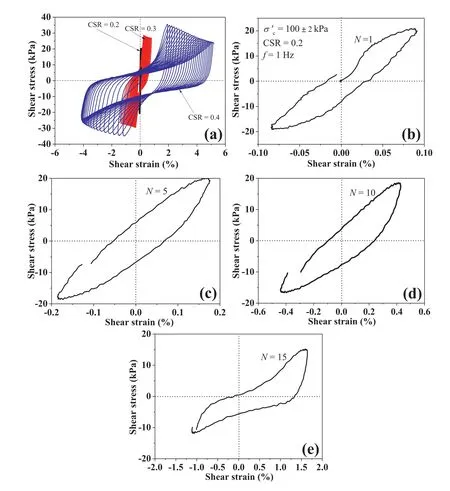
Fig.7.Hysteresis loops at different loading CSR values and numbers of cycles.
Stress-controlled tests were conducted at different cyclic shear stress(τ= σd/2)amplitudes ranging from 10 kPa to 40 kPa,represented by CSR=0.1-0.4,as listed in Table 2.The tests were conducted on the specimens prepared at different ranges of dry density and water content at σ′c=(100 ± 2)kPa,and was subjected to loading frequency of 1 Hz.A typical plot of the variations in stress-strain relation during different cyclic shear stress amplitudes is presented in Fig.7a.Fig.7b-e presents the variations in shear stress(τ)and shear strain(γ),also called hysteresis loop,at different numbers of loading cycle(N),i.e.N=1-15,for CSR=0.2.It was seen that the hysteresis loops obtained at different N values in between 1 and 10 are almost symmetrical,whereas at N=15,and beyond,the loops are highly asymmetrical.Therefore,to evaluate the shear modulus(G)and damping ratio(D)of cohesive soil,the methodology proposed by Kumar et al.(2017)has been adopted for all hysteresis loops.
Fig.8 depicts that the variations in shear modulus(G),shear modulus reduction(G/Gmax)and damping ratio(D)obtained from stress-controlled loading.Fig.8a represents the variations in G with shear strains for different soil specimens(S1-S9).Based on the results obtained for specimens S1-S7,it was seen that G values obtained from all tests follow very narrow range of scatter and are independent of initial dry densities,water contents and degrees of saturation.It can also be seen that G is affected by the variation of confining pressure(test series S8,S1-S7 and S9).Fig.8b illustrates the variations in normalised shear modulus(G/Gmax)with shear strains for specimens S1-S9.It can be seen that the variation of G/Gmaxwith σ′clies in a very narrow range of scatter,and hence can be considered to be unaffected by confining pressure.In most of the geotechnical engineering applications concerning dynamic loading,G/Gmaxcurve is one of the essentially required input parameters.In order to estimate the same,Gmaxof cohesive soil,subjected to different values ofwas evaluated using the empirical correlation proposed by Hardin and Drnevich(1972b):

where e is the void ratio,OCR is the over consolidation ratio(for present study,OCR=1),σ′cand Gmaxare in Pa.
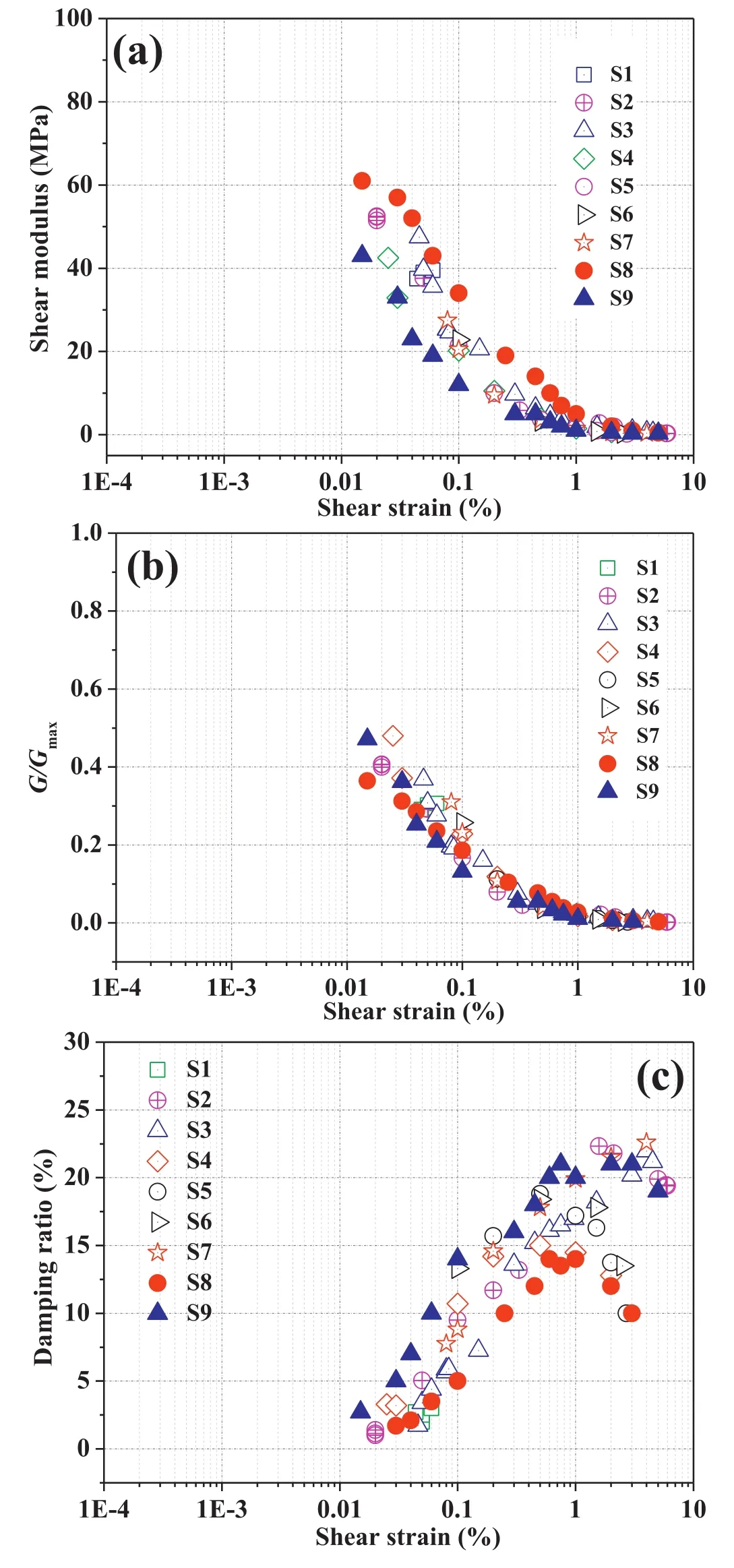
Fig.8.Variations of(a)shear modulus,(b)G/Gmax,and(c)damping ratio with shear strain.
Fig.8c presents the variations in damping ratio(D)of test specimens S1-S9,suggesting that the damping ratio is independent of the variations in dry densities,water contents and degrees of saturation.However,the results reveal that the scatter in the obtained estimates of D with the variation in confining pressure(test specimens S1-S7,S8 and S9)is more than that obtained for G.Fig.8c also indicates that D increases with the increase in shear strain,followed by decreasing trend beyond 1%shear strain for all three cases ofσ′c.
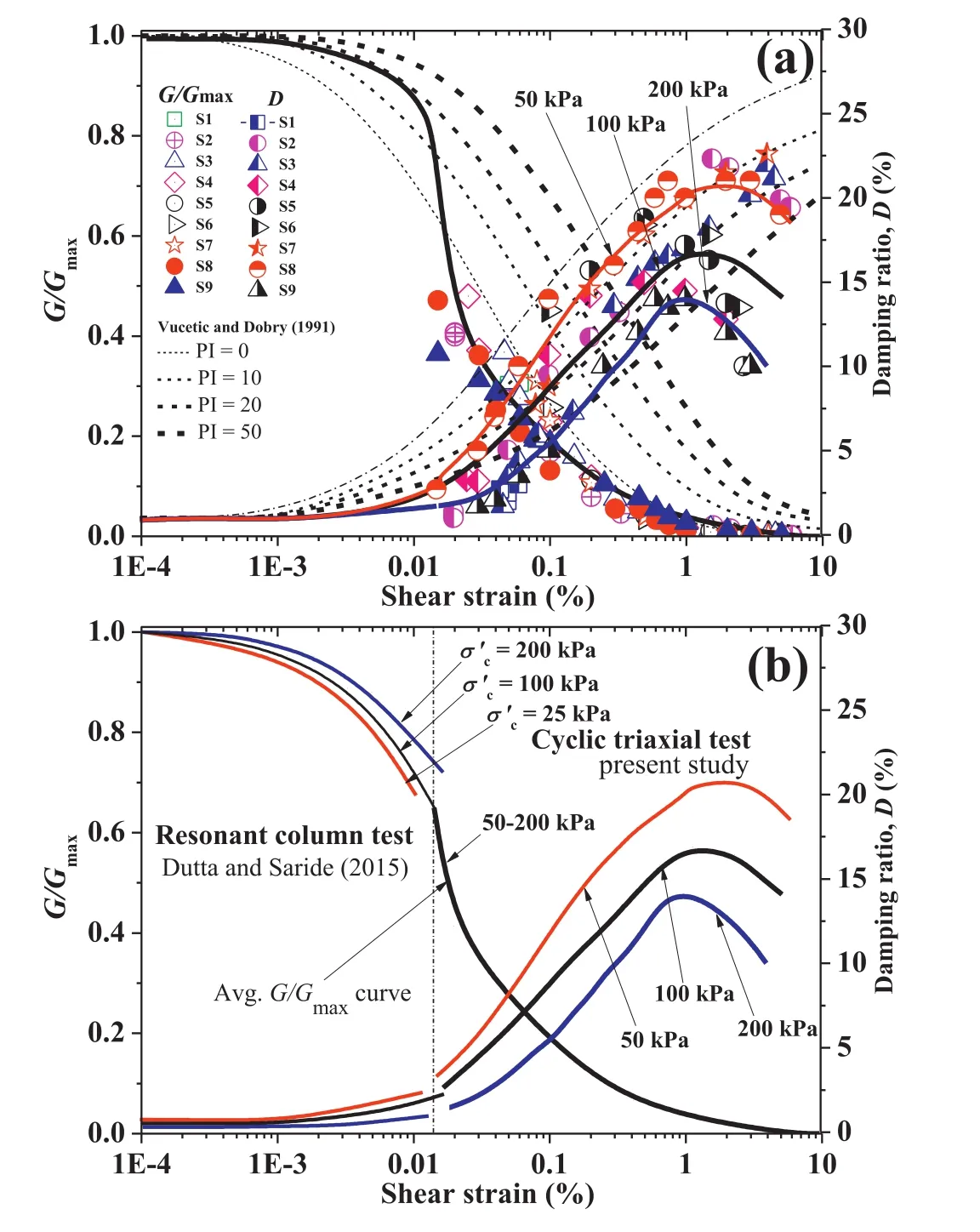
Fig.9.(a)Average plot of G/Gmaxand damping ratio curves in comparison with Vucetic and Dobry(1991)model;and(b)Variation of G/Gmaxand damping ratio curves in combination with Dutta and Saride(2015).
To provide the dynamic properties of soil for wide range of shear strains(from low to high strain levels),the strain-dependent shear modulus reduction and damping ratio values for shear strain less than 0.01%were considered from Vucetic and Dobry(1991),and that from Dutta and Saride(2015),as shown in Fig.9a and b,respectively.Fig.9a represents the estimated G/Gmaxand D curves of cohesive soil for PI=18.9%in comparison to the standard curves proposed by Vucetic and Dobry(1991)for PI ranging between 0 and 50%.The significant difference in G/Gmaxand D curves,obtained from the present experiment and standard model,is attributed to different particle sizes of soils and other associated index properties.It is also seen that the damping curve proposed by Vucetic and Dobry(1991)shows almost increasing and asymptotic response up to shear strainγ=10%,whereas the same obtained from the present study shows a decreasing response beyond γ=1.5%.Similar behaviour of damping ratio for sandy soil was reported by Kumar et al.(2017).Therefore,the estimation of dynamic soil properties of any regional soils is very important to precisely devise the approach to design the aseismic structures of the specific region.

Fig.10.Typical plots of the variations in G,D and ruduring staged loading.
Fig.9b presents the combined soil curves(shear modulus degradation and damping ratio curves)obtained from the present study with that proposed by Dutta and Saride(2015)for a typical Indian cohesive soil subjected to shear strain lower than 0.01%. Dutta and Saride(2015)have conducted resonant column tests on the compacted cohesive soil(index properties:Gs=2.8,MDD=1.68 g/cm3,OMC=22%,LL=58%,PL=20%,PI=38%)to determine the dynamic soil properties for 0.0001%<γ<0.1%.Based on Fig.9a and b,it can be stated that the dynamic properties of cohesive soil for shear strain less than 0.01%as obtained from standard model by Vucetic and Dobry(1991)are significantly different from that obtained by Dutta and Saride(2015)for Indian regional soil.Hence,in the absence of low-strain dynamic properties of typical Indian cohesive soils having nearly similar aforementioned index properties,Dutta and Saride(2015)’s soil model can be cautiously used.However,for proper estimation of response,each of the subsurface stratification should be dynamically characterised.
A typical plot of the response of cohesive soil,in terms of variations in G,D and ruwith shear strain,during staged cyclic loading,is presented in Fig.10.It shows that the shear modulus of cohesive soil decreases,whereas damping ratio increases with the increase in shear strain.The increase in ruwith shear strains is also observed,however,a reduction in ruis noticed at the time gap between two staged cyclic loadings.This is attributed to the time-lag(nearly 5 s)between the subsequent loading stages,during which there remains high possibility of the redistribution of ruwithin the soil specimen.This redistribution may cause slight densification of the soil specimen during the time gap between the loading stages.Similar observations were also reported by Yoshida(2015).Yasuda et al.(1994)conducted strain-controlled tests(called fresh-cyclic tests)and staged cyclic tests,and reported that the damping ratio was not affected by the testing conditions,whereas shear modulus was found to be slightly affected beyondγ=0.01%due to generation and accumulation of ru.The excess PWP ratio ruwas observed to slightly decrease before commencing the subsequent loadings of higher stress levels;however,γand D exhibited an increasing response.The higher value of CSR implies higher deviatoric stress on the specimens,thus resulting in higher shear strain.Therefore,in the case of cohesive soils,rather than the pore pressure criterion,it suggests that the shear strain criteria for liquefaction evaluation would be more appropriate.
5.2.Liquefaction potential of cohesive soil
Fig.11 presents the variations in ruandγ,measured during undrained cyclic loading,to evaluate the liquefaction potential of cohesive soil specimens prepared at different dry densities and water contents(Specimens S1-S9 as mentioned in Table 2).From Fig.11a,it is seen that the specimen S1 tested at total confining stress(σ′c)of(100 ± 2)kPa(without any saturation)shows incremental ruup to 2000 cycles.Since the specimen S1 was prepared at MDD and OMC,in which almost 95%saturation level was already attained,application of loading cycles in undrained conditions is responsible for the increase in PWP.The specimens S2 and S3 were tested at saturated condition for CSR ranges of 0.1-0.3 and 0.2-0.4,respectively.The specimen S2 shows incremental response of PWP uptoCSR=0.2,followed bysudden drop just before the application of CSR=0.3.As explained earlier,this PWP drop is due to the timelag between the end of the preceding loading stage(CSR=0.2)and the succeeding loading stage(CSR=0.3).It is also seen that the initial ruis higher in S3 than S2,since S3 was initially subjected to high amplitude of stress(CSR=0.2).Both the specimens S2 and S3,prepared at MDD and OMC,reflects the maximum ru≤0.6 at 2000 cycles.A sudden drop in ruwas observed just before the application of CSR=0.3 and 0.4 for specimens S2 and S3,respectively.The specimens S4 and S5 were prepared at a dry density of 1.5 g/cm3and water content of 8%.The specimen S4 shows ru≈1,when subjected to CSR=0.1 and followed by CSR=0.2,whereas the specimen S5 shows the same with CSR=0.2 at the 13th cycle.The specimen S6,prepared at dry density of 1.5 g/cm3and water content of 15%,shows ru≈1 at the 15th cycle,when subjected to CSR=0.2.It has also been seen that the specimen S7,prepared at dry density of 15 g/cm3and water content of 25%,does not show ru≈1,when subjected to CSR=0.2 and followed by CSR=0.3.The variations in ruobtained for the specimens S5,S6 and S7 show that the resistance of liquefaction increases with the increase in initial water content,when these specimens are subjected to CSR=0.2.
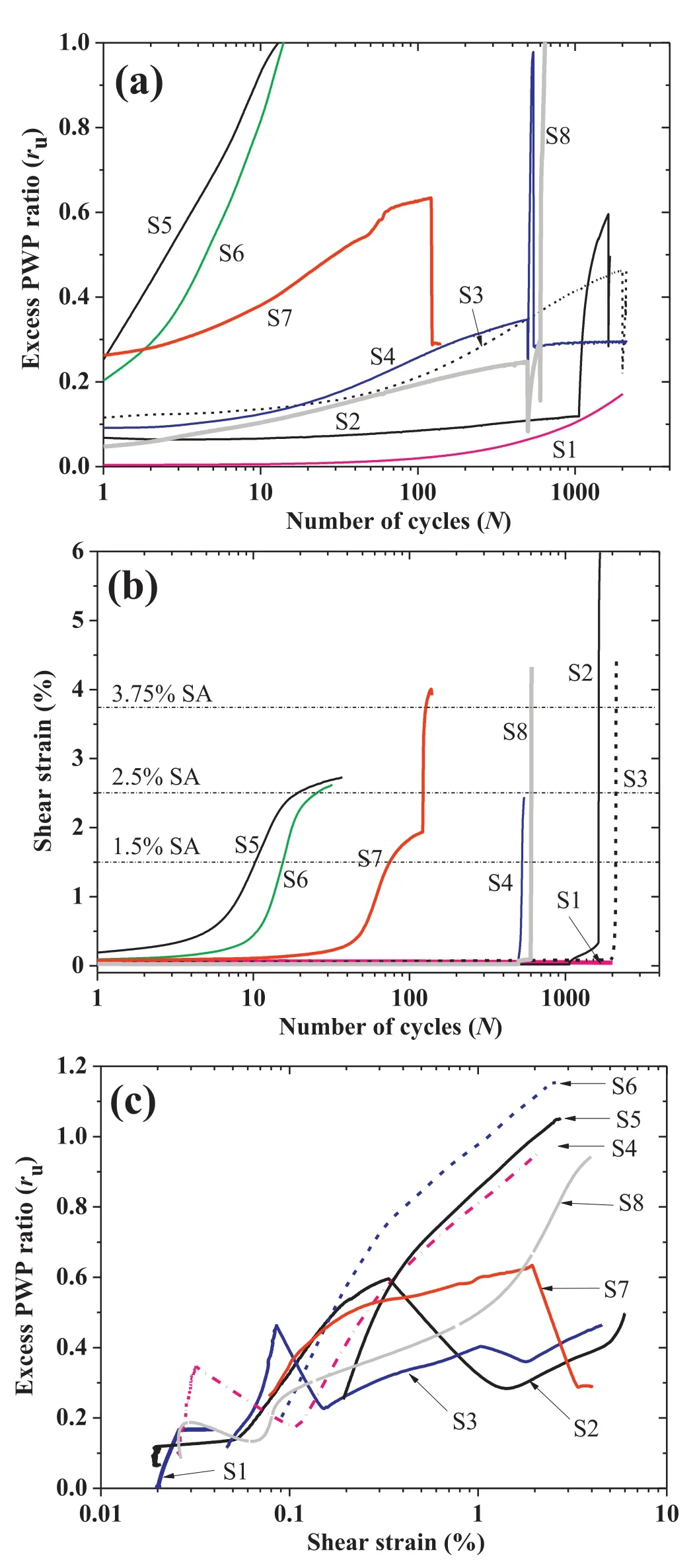
Fig.11.Variations in(a)ruand(b)γwith N;and(c)Variations in ruwith γ.
Fig.11b presents the accumulation of shear strain during undrained cyclic loading in the specimens S1-S8.It has been seen that the specimens S1-S3,prepared at MDD and OMC,reflect the maximum shear strains(γmax)at the end of tests as 0.02%,6%and 4.5%,respectively.As reliable pore pressure measurements are difficult in cyclic testing due to relatively low permeability,in this circumstance,the criterion of 3.75%single-amplitude(SA)shear strain is convenient to define liquefaction of cohesive soils.The specimens S2 and S3 are found to satisfy the above criterion to exhibit liquefaction,while specimen S1 did not show any signs of liquefaction.Similar SA shear strain criterion for the evaluation of liquefaction potential in cohesive soil was reported by Ishihara(1996)and Perlea(2000).The specimens S4 and S5,prepared at dry density of 1.5 g/cm3and water content of 8%,show liquefaction(ru=1)at 2.5%SA shear strain is attributed to the relatively higher permeability compared to the specimen prepared at MDD and OMC.Similar observations were found for the specimens S6 and S7,prepared at same dry density(1.5 g/cm3)and different water contents of 15%and 25%,respectively.The specimen S7 was found to liquefy as it reached 3.75%SA shear strain,while the specimen S6 exhibited liquefaction due to the excess pore pressure ratio attaining the value of 1 at a shear strain of 2.5%.Hence,cohesive soils can be said to attain the state of liquefaction at a shear strain of 3.75%(even if ru<1),or the shear strain at which ru=1,whichever is lower.Cohesive soils may not lose complete strength during cyclic loading,even if soils are saturated and rureaches 1,due to the cohesive bond presented amongst the soil particles.Therefore,the strain-based criterion to quantify the liquefaction in cohesive soil can be a best option when ruis not prominent.Fig.11c presents the variations in ruwith shear strain for the specimens S1-S8.It can be clearly stated that the cyclic threshold shear strain for cohesive soil is approximately 0.02%,beyond which the initiation of excess PWP due to cyclic loading is observed.
6.Conclusions
Based on the results obtained from the stress-controlled staged cyclic loading on cohesive soils,the following conclusions are drawn:
(1)The shear modulus degradation(G/Gmax)and damping ratio curves are independent of the initial dry density and water content of the specimens.The effect of confining pressure on G/Gmaxis insignificant,while the effects on damping ratio curves are prominent.
(2)The standard dynamic curves proposed by Vucetic and Dobry(1991)for cohesive soils are found unsuitable to represent the dynamic characteristics of the typical cohesive soil found in the northeastern India.The damping ratio curves beyond a shear strain of 1%are significantly different.
(3)The low-strain dynamic characteristics of Indian cohesive soil(proposed by Dutta and Saride,2015)are compatible with the trend of high-strain dynamic characteristics reported in the present study.Hence,in the absence of low strain characteristic data for typical Indian cohesive soils,the dynamic model from Dutta and Saride(2015)can be effectively used.
(4)The strain-dependent dynamic properties of cohesive soils in northeastern India,obtained from staged-loading tests,can be suitably used to assess the ground response analysis of the region,in combination with similar properties reported for sandy deposits(Kumar et al.,2017).
(5)The shear strain based liquefaction criterion for cohesive soils is proposed.Cohesive soil will be considered to be liquefied at(a)SA shear strain of 3.75%(even if ru<1),or(b)the shear strain at which ru=1,whichever is lower.
(6)The ground response assessment of any region should be conducted based on the dynamic properties of the soils from the specific region.Direct adoption of the standard curves will lead to improper results,primarily due to the differences in the composition and stress state of the soil used to develop the standard curves.
Conflict of interest
The authors wish to confirm that there are no known conflicts of interest associated with this publication and there has been no significant financial support for this work that could have influenced its outcome.
List of abbreviations and symbols
B Skempton’s pore pressure parameter
BP Back pressure
CP Cell pressure
CSR Cyclic stress ratio
D Damping ratio
DrRelative density
e Void ratio
F Frequency of sinusoidal waveform
G Shear modulus
GmaxMaximum shear modulus
G/GmaxNormalized shear modulus
GRA Ground response analysis
GsSpecific gravity
LL Liquid limit
MDD Maximum dry density
N Number of cycles
OCR Over consolidation ratio
OMC Optimum moisture content
PI Plasticity index
PWP Pore water pressure
ruExcess PWP ratio(Δu/Δσc)
Δu Change in PWP
ΔσcChange in confining stress
σdDeviatoric stress
SA Single amplitude
wcWater content
γ Shear strain
γmaxMaximum shear strains
γdDry density of soil
σ′cEffective confining stress
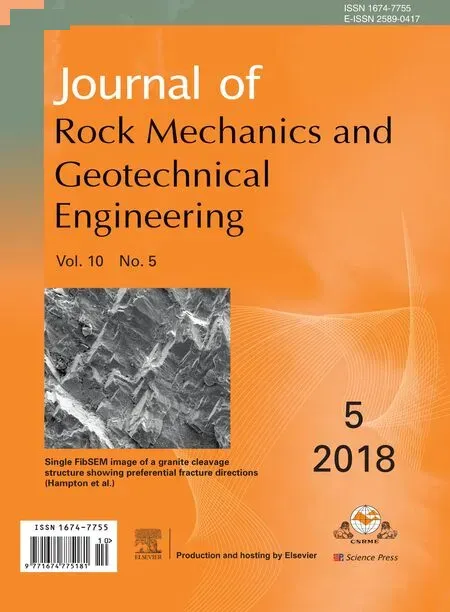 Journal of Rock Mechanics and Geotechnical Engineering2018年5期
Journal of Rock Mechanics and Geotechnical Engineering2018年5期
- Journal of Rock Mechanics and Geotechnical Engineering的其它文章
- Pullout behavior of polymeric strip in compacted dry granular soil under cyclic tensile load conditions
- Blast-induced rock damage control in Fangchenggang nuclear power station,China
- A comparative study between gravel and rubber drainage columns for mitigation of liquefaction hazards
- Bearing behavior and failure mechanism of squeezed branch piles
- Experimental evaluation of mechanically stabilized earth walls with recycled crumb rubbers
- Saturated anisotropic hydraulic conductivity of a compacted lateritic soil
